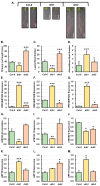Molecular Manipulation of the miR160/ AUXIN RESPONSE FACTOR Expression Module Impacts Root Development in Arabidopsis thaliana
- PMID: 39202402
- PMCID: PMC11353855
- DOI: 10.3390/genes15081042
Molecular Manipulation of the miR160/ AUXIN RESPONSE FACTOR Expression Module Impacts Root Development in Arabidopsis thaliana
Abstract
In Arabidopsis thaliana (Arabidopsis), microRNA160 (miR160) regulates the expression of AUXIN RESPONSE FACTOR10 (ARF10), ARF16 and ARF17 throughout development, including the development of the root system. We have previously shown that in addition to DOUBLE-STRANDED RNA BINDING1 (DRB1), DRB2 is also involved in controlling the rate of production of specific miRNA cohorts in the tissues where DRB2 is expressed in wild-type Arabidopsis plants. In this study, a miR160 overexpression transgene (MIR160B) and miR160-resistant transgene versions of ARF10 and ARF16 (mARF10 and mARF16) were introduced into wild-type Arabidopsis plants and the drb1 and drb2 single mutants to determine the degree of requirement of DRB2 to regulate the miR160 expression module as part of root development. Via this molecular modification approach, we show that in addition to DRB1, DRB2 is required to regulate the level of miR160 production from its precursor transcripts in Arabidopsis roots. Furthermore, we go on to correlate the altered abundance of miR160 or its ARF10, ARF16 and ARF17 target genes in the generated series of transformant lines with the enhanced development of the root system displayed by these plant lines. More specifically, promotion of primary root elongation likely stemmed from enhancement of miR160-directed ARF17 expression repression, while the promotion of lateral and adventitious root formation was the result of an elevated degree of miR160-directed regulation of ARF17 expression, and to a lesser degree, ARF10 and ARF16 expression. Taken together, the results presented in this study identify the requirement of the functional interplay between DRB1 and DRB2 to tightly control the rate of miR160 production, to in turn ensure the appropriate degree of miR160-directed ARF10, ARF16 and ARF17 gene expression regulation as part of normal root system development in Arabidopsis.
Keywords: ARF10; ARF16; ARF17; AUXIN RESPONSE FACTOR (ARF); Arabidopsis thaliana (Arabidopsis); miR160; miR160 expression module; miR160-directed gene expression regulation; microRNA (miRNA); molecular manipulation; root development.
Conflict of interest statement
The authors declare no conflicts of interest.
Figures




Similar articles
-
The Arabidopsis thaliana Double-Stranded RNA Binding Proteins DRB1 and DRB2 Are Required for miR160-Mediated Responses to Exogenous Auxin.Genes (Basel). 2024 Dec 21;15(12):1648. doi: 10.3390/genes15121648. Genes (Basel). 2024. PMID: 39766914 Free PMC article.
-
MiR160 and its target genes ARF10, ARF16 and ARF17 modulate hypocotyl elongation in a light, BRZ, or PAC-dependent manner in Arabidopsis: miR160 promotes hypocotyl elongation.Plant Sci. 2021 Feb;303:110686. doi: 10.1016/j.plantsci.2020.110686. Epub 2020 Oct 20. Plant Sci. 2021. PMID: 33487334
-
MicroRNA-directed regulation of Arabidopsis AUXIN RESPONSE FACTOR17 is essential for proper development and modulates expression of early auxin response genes.Plant Cell. 2005 May;17(5):1360-75. doi: 10.1105/tpc.105.031716. Epub 2005 Apr 13. Plant Cell. 2005. PMID: 15829600 Free PMC article.
-
Repression of AUXIN RESPONSE FACTOR10 by microRNA160 is critical for seed germination and post-germination stages.Plant J. 2007 Oct;52(1):133-46. doi: 10.1111/j.1365-313X.2007.03218.x. Epub 2007 Aug 2. Plant J. 2007. PMID: 17672844
-
TARGET OF MONOPTEROS: key transcription factors orchestrating plant development and environmental response.J Exp Bot. 2024 Apr 15;75(8):2214-2234. doi: 10.1093/jxb/erae005. J Exp Bot. 2024. PMID: 38195092 Review.
Cited by
-
The Arabidopsis thaliana Double-Stranded RNA Binding Proteins DRB1 and DRB2 Are Required for miR160-Mediated Responses to Exogenous Auxin.Genes (Basel). 2024 Dec 21;15(12):1648. doi: 10.3390/genes15121648. Genes (Basel). 2024. PMID: 39766914 Free PMC article.
-
DRB1, DRB2 and DRB4 Are Required for an Appropriate miRNA-Mediated Molecular Response to Osmotic Stress in Arabidopsis thaliana.Int J Mol Sci. 2024 Nov 22;25(23):12562. doi: 10.3390/ijms252312562. Int J Mol Sci. 2024. PMID: 39684274 Free PMC article.
References
MeSH terms
Substances
LinkOut - more resources
Full Text Sources

